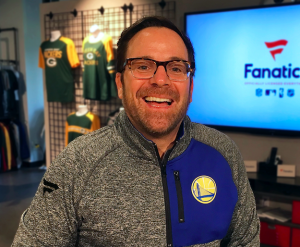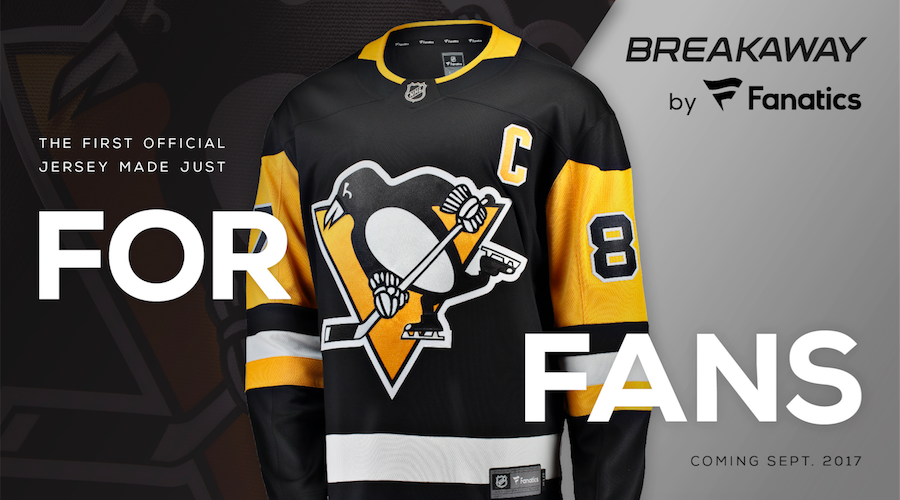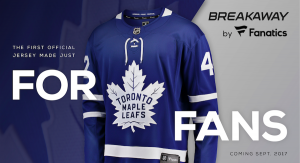Over the last two years, several of the industry’s major players have inked blockbuster licensing deals with the major sports leagues, including Under Armour (MLB), Nike (NBA) and Adidas (NHL).
In each one, Fanatics has more quietly secured part or all of the licensing rights for the fan piece of the licensing pie. The partnerships come as Fanatics has invested millions over the last few years building up its vertical manufacturing capabilities to be able to quickly address both faster speed-to-market of merchandise and the hot market opportunities that drive the sports licensing business while mitigating the obsolete inventory risks that have plagued many participants.
Next up for fans will be the September launch of official NHL fan jerseys, which for the first time ever will be designed, manufactured and distributed through retail channels by Fanatics. Completely redesigned with the fan in mind, the “Breakaway” jersey will be a revolutionary product that promises a number of advancements in design, comfort and fit.
Here, Raphael Peck, president of Fanatics Branded, discusses the new NHL jersey and Fanatics’ ongoing vertical transformation.
What’s behind Fanatics’ numerous deals with the leagues? Obviously, we’re always going to the leagues and discussing ways to expand the fan base and provide better product more quickly and efficiently. But our organization is scaling and leveraging and we feel like we have developed a special ingredient based on how we can utilize data, how we take verticalization and technology, define it with the agility and speed of an owned vertical supply chain, to address the sports licensing environment. And that core ingredient is absolutely working for us. We’re really utilizing data in a way that allows us to identify consumer preferences in a super effective manner. And when you combine that with the fact that organically customers are migrating online as well, I think it checks up for an incredibly agile business model and we’ll continue to leverage that.
Is it largely around capturing better margins for Fanatics and the leagues? At the end of the day the name of the game in the sports licensing business is, how do you grow the space? And an agile supply chain and innovative business model allows you to do that. Verticalization helps with inventory ownership and speed to market. Combining that with big data, our product creation engine can identify, anticipate and react to consumer demand. And if you can continue to do that at scale, you can address a much wider audience. And if you can address a wider audience, you can grow a business that by and large over the last few years has been pretty stagnant.
What’s unique about the NHL deal? We gained exclusive rights to the Breakaway jersey, an incredible new product that will allow us to flex our muscle for the first time to show what our product creation engine can do. Second, Fanatics gained expanded distribution rights relative to wholesale and we can now sell the jerseys to retailers so it allows us to begin to operate our business in an omnichannel environment. Finally, there’s the exclusivity piece around hot market, where we’re exclusive in both headwear and t-shirts for Stanley Cup winners. So it’s really those three areas where we’ll be able to maximize the assortment for fans.
Can you discuss the NHL fan jersey redesign? The National Hockey League has done an incredible job developing a beautiful authentic jersey, but it’s one which commands a high price point. When we gained the exclusive fan jersey rights, the first thing we wanted to do was ensure we were creating a product that fit the needs and wants of fans worldwide. So we reached out to over 15,000 fans and invited them to be part of the design solution. What we heard back was: ‘My jersey fits big,’ ‘I can’t fold it,’ ‘It has to be hung,’ ‘I struggle to launder my jersey and wash it properly, ‘It’s heavy and ‘it’s scratchy.’ And from women we heard, ‘I don’t love the fit,’ and overall women told us that against their skin it really doesn’t feel good.
And we took all these issues and said, how do we take weight out of the jersey, make it more malleable so that it can be folded and laundered and how do we refine the fit? Most of the current fan jerseys really would look better on someone who was wearing shoulder pads. So while we didn’t want to lose the authentic look, we wanted to make them appear less baggy or boxy. So we really approached this very methodically and developed what we call Fan Features. First there’s Fan Flex, an incredible new textile that supports embroidery and other forms of embellishment that go on a jersey to make it more comfortable. We also have Fan Fit, where we employed a digital model to analyze body forms to truly understand how to maximize the fit of the jersey. And then we have Fan Shield, a technology that manages moisture. Fans are always moving in different temperatures so cool and dry was a really important component to the redesign.
So these Fan Features become baseline components that we believe will be an absolutely incredible component to jerseys in the future, including our new NBA product doming out later this year.
So the jersey look basically doesn’t change? Yeah. The National Hockey League is incredibly disciplined about the heritage of the league and respect for the teams. And some teams are more open-minded to change than others. But by and large the official on-ice jersey is being overseen by Adidas and clearly that brand is going to work directly with the NHL to sort of set the basic baseline context of the aesthetic. There are some liberties that we can take creatively, and we have, but every time we take a creative liberty we make sure that it’s value additive to the jersey and to the fan and that the teams really, really love it. So we’re excited about the aesthetic. Overall, the biggest change to the National Hockey League jersey is that that you are actually going to have by and large crew-neck jerseys on the ice for the first time in decades and you’re going to go away from the traditional V or lace up to much more of a crew-neck type look. Even where there are lace-up jerseys, those will be integrated into the crew neck as well.
What about the women’s jersey? There are major changes to the women’s jerseys, specifically around the fit. There’s some really nice fan gear out there now for women but the jersey is really the backbone of the business and if you get the jersey fit right you can go far from there.
Will Fanatics’ set-up allow the league to better pursue hot market opportunities? Hot market is the center of our business and it’s all about quick-response reaction. It’s about inventory, it’s about speed to market, and it’s about assortment. You need all of those boxes fully checked. Once you own your vertical business structure and your domestic manufacturing capability, your hot market engine can really, really flex.
So we feel we have two sustainable competitive advantages around managing hot markets. One is we’re one of the largest digital manufacturers in the U.S. and that digital muscle online allows us to address the e-commerce stuff very, very quickly. The second part of our model is our new vertical integration with Majestic. That’s going to make our engine that much bigger and more efficient on the wholesale side where we add verticalization and are able to get product out the door inside of 24 hours to retailers. So not only are we going to really, really flex as it relates to our e-commerce customer model for hot markets, but now we’re really going to be focused on how do we get faster on the wholesale side and flex that agility and that data to get the product out the door even faster to improve the customer experience for our wholesale customers.
Can you discuss your plans for Majestic? They’ve been part of the Fanatics network for about three months now and we’re in a deep process of breaking down how to best mesh all of their incredible resources with our capabilities. It’s an exciting process to see how the two companies will continue to join forces and create more diverse opportunities and offerings for fans, retailers, leagues and partners.
When did Fanatics start making its own product and why the ramp-up? When I came onto the business about four years ago, we were making a limited amount of product, largely in the collegiate area. Over a period of time, we realized that verticalizing the sports business model in licensing was absolutely critical. The first challenge is obviously managing inventory turns because of the multiples of colors and sizes you deal with. Second was the lack of predictability of wins and losses. You’re not always fighting fashion, you’re actually fighting a question of, did the worst team from last season become the best team this season? And if so, how can you pivot to address?
And the third thing is, we needed to get quicker to handle the wider assortment expected online. For instance, if you go to a typical sporting goods store, you might be able to find the top three players on a team. For us, we’re going to make sure any player on the roster is going to be available to you at any time. Finally, we wanted to address customization. How do you create a great customer relationship by allowing the customer to communicate with you and relate back to you through an incredible custom engine? So assortment and customizing are very, very important. But the big overall benefit of inventory-level verticalization is being able to utilize disruptive data in constantly feeding information into the merchandising engine. When you can learn at that speed and adapt and adjust, it creates incredible agility.
What does Fanatics’ verticalization push mean for third-party vendors? We believe in providing fans with the widest assortment of quality products available, and there are a lot of very, very good brands producing really creative, innovative fan gear. Ultimately, fans want choice, and we make sure to partner with many top brands that help us create the largest and most diverse merchandise offering available.
Do you plan on pursuing similar deals down the road with the NFL and other organizations? As we continue to grow our business model and learn – which is something we love to do – we hope that we can continue to expand the fan base and drive better product into the marketplace across retail channels faster to improve the fan experience. As long as we can keep doing that, we can grow our relationships with the leagues and find new opportunities to create fan interest, grow the leagues’ brands, get better product into the marketplace and grow the industry overall. With Majestic, we’re adding an incredible wholesale engine to our vertical integration capabilities and when we put this next piece together, we absolutely hope to continue to take that model and look at other opportunities to continue to leverage our investment in the business.
Photos courtesy Fanatics

















